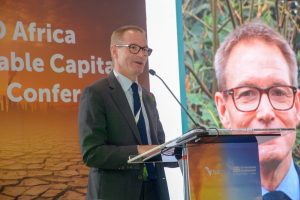Nairobi, 24th July 2024 – Shortlist and FSD Africa, with analysis from the Boston Consulting Group, today published “Forecasting Green Jobs in Africa,” a first of its kind report that forecasts the new direct job creation potential of 12 “green” sub-sectors by 2030. The report predicts the creation of up to 3.3 million new direct green jobs across the continent by 2030, with the majority in the renewable energy sector, particularly solar. The study, the first in-depth analysis of workforce needs within major green value chains over the next five years, provides detailed forecasts for five focus countries, Democratic Republic of Congo (DRC), Ethiopia, Kenya, Nigeria and South Africa, which together account for more than a fifth (22%) of new jobs, and in key sectors such as renewable energy, e-mobility, agriculture, construction and manufacturing.
“Forecasting Green Jobs in Africa” underscores the critical importance of a skilled workforce as an input accelerating African green industries, emphasizing the need for substantial investment in skills development and workforce mobilization. Moreover, the millions of jobs created in the green revolution will also contribute to the formalization of African economies, and the inclusion of whole populations in stable systems of remuneration, social security and taxation for the first time.
Based on the findings, the report also outlines key strategies required to cultivate Africa’s green jobs ecosystem: from targeted investments in high-potential sectors and value chains, the fostering of cross-sector collaboration among governments, private sector, educational institutions and investors, to the development of comprehensive support policies for green sectors. The report also calls for further analysis and granularity to labour demand key value chains to identify Africa’s current skilled labour supply and any potential gaps.
While some experts have suggested that up to 100 million green jobs may be created by 2050, this report takes a more near-term, sober, and realistic look at the job creation potential of just 12 specific sub-sectors or value chains and only until 2030. This more conservative analysis is intended to guide near-term investments and policy decisions among universities, workforce development actors, and government as we ensure the mobilization of the right skills and workforce to meet demand.
Significantly it predicts that 60% of the employment generated by the green economy over the coming six years will be skilled or white collar in nature. Within this, 10% constitute “advanced jobs” (highly skilled, requiring university degrees to fulfil), whilst a further 30% are projected to be “specialized” (requiring certification or vocational training) and 20% will be administrative in emphasis. Crucially, these job types tend to attract higher salaries and will, therefore, play a central role in spurring the growth of the middle class in countries hosting these high-growth sectors. Important also is the stability of the unskilled jobs created – which will offer ladders up the employment scale for candidates, whose employability will be enhanced by access to training and experience.
“There is a cross-sector effort across Africa to spur employment and sustainable development,” said Mark Napier, CEO of FSD Africa, “but stakeholders lack a shared, granular understanding of where the green jobs are going to come from. This report offers a methodology for forecasting green jobs which allows us to get practical about where we need to invest to make these jobs happen.”
“This is the first public report that takes seriously the notion that human capital and talent is important as both an input to green economic growth, and as a positive outcome – in the form of millions of new, direct jobs.” says Paul Breloff, CEO of Shortlist. “Now policymakers, and funders, and workforce developers need to step up to meet this near-term demand with effective training, apprenticeships, and job/skill matching, in hopes of achieving Africa’s green promise.”
Other key findings include:
- South Africa, Kenya and Nigeria represent the highest job creation potential (16%) due to population, gross domestic product (GDP) and industry maturity
- The renewable energy sector alone is expected to generate up to 2m jobs (70% of the total) of which 1.7m will be in solar
- Solar is the most important contributor to green jobs in South Africa (140,000 jobs) and Kenya (111,000 jobs)
- Hydroelectric is forecast to be the leading employer in both DRC (16,000 jobs) and Ethiopia (33,000)
- Agriculture and nature are forecast to produce up to 700,000 jobs (25% of total), of which more than half (377,000) will come from climate smart agriculture technology
Jobs created by country
South Africa
- South Africa: between 85,000 to 275,000 new green jobs are forecast by 2030 – mainly in energy and power production, and agriculture and nature
- The solar sector leads job creation in South Africa with 140,000 jobs projected
Nigeria
- Nigeria predicted to put on between 60,000 and 240,000 new green jobs by 2030
- Aquaculture and poultry lead job creation, with 69,000 jobs projected
Kenya
- Kenya predicted to put on between 40,000 to 240,000 green jobs by 2030
- The solar sector leads this job creation, with estimates that it will generate 111,000 jobs in the country by the decade’s end
Ethiopia
- Ethiopia will see between 30,000 and 130,000 new green jobs by 2030, mainly in energy and power production
- Hydropower generation leads as a job-creating sector, with 33,000 jobs projected
Democratic Republic of Congo (DRC)
- The DRC is predicted to put on between 15,000 to 45,000 new green jobs by 2030; mainly in energy and power production and distribution
- Again, hydropower is expected to lead job creation as a sector with 16,000 jobs expected
Click here to download a copy of the report




